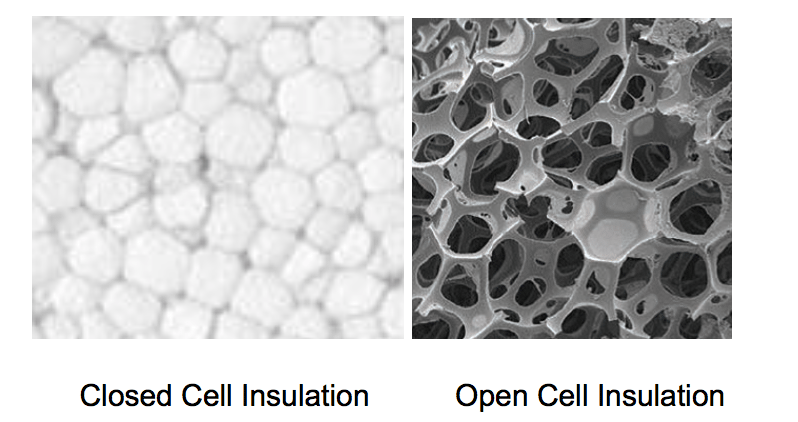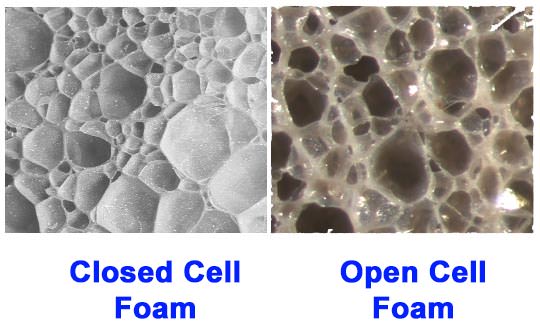Two Types
There are two main types of foam that we work with when it comes to acoustics. Well, it is really one foam type we work with but one type gets confused with the other. With foam, there are two main types. There are open-celled foam and closed celled foams. These two foam types are confused often in their form and function. One is designed to be sat on and one is designed to absorb energy. Let’s examine both types as to their function and their forms. Closed-cell foam is used in furniture such as seat cushions for your sofa and your chairs. Open celled foam is the foam type that we use in the acoustic world to absorb sound. Let’s examine both types of form and function.
Closed Cell Foam
Closed-cell foam is exactly what the name implies. The cell structure is a closed-cell that is not open. The cells are closed since the function of the foam is rigidity and support. Closed-cell foams are designed to be sat upon, keep materials that are shipped protected from damage, insulate our homes and a host of many other functions. Closed celled foams are often used in keeping our homes warm and cold. It is for BTU retention. Closed celled foams are denser in their structure. They weigh more and can achieve densities of 1.75 – 2.00 lbs per cubic foot. Following their insulation function, they have R-value ratings. An R-value is a measurement of a substance’s resistance to heat flow. This measurement is used to determine how well they insulate our homes or buildings by retaining heat and cooler air. Closed celled foams are designed to produce a much higher R-value than open-celled foams. This higher R-value means they are better suited for more extreme temperature situations.
Benefits
When it comes to insulation of our dwellings we need to look at what is best for space we have available to use. Closed-cell foam is best used we have a small amount of space to use and we need a high R-value. Closed-Cell foam can achieve twice the R-value as an open-celled foam within the same space requirement. Since the cell structure is closed, it can also contribute to the rigidity of the structure in which it is used. Closed-cell can also act as a barrier against water vapor or moisture seepage. Once it does get wet, it will usually not be harmed by the moisture. Closed-cell foams can also be used within seat cushions for support and comfort. We have also seen it used as packing material for shipping bulky items.
Open – Celled Foam
How does acoustic foam work? All we have to do to understand how does acoustic foam works is to look at the individual cell structure of the foam. You can see that the cell structure is open or porous in nature. This cell structure type allows for air to flow into the foam and enter the individual cells. Once it is in the cells, it moves around and this movement creates friction. We all know that friction can produce heat. If you have ever rubbed sticks together when camping to create a fire, you realize how friction works. Once the friction starts to produce heat, an energy transformation occurs. We do not lose energy, we change its form to heat. Energy is never destroyed. This energy process change reduces the amplitude or strength of the energy that has entered the foam. This process is then called sound absorption.
Middle and High Frequencies Only
Airborne energy that strikes our open-celled foam is middle and high-frequency energy. Lower frequency energy is wave energy like ocean waves. Lower frequency wave energy is long and strong and oscillates in cycles throughout our room. Middle and high-frequency energy is ray energy. Ray’s energy is like sunshine. The wavelength energy is shorter in length and can move through the air. When you are trying to figure out how does acoustic foam work, you must always look at airflow. It is the airflow across the foam that creates friction which produces heat. With the heat, we have an energy transformation and thus sound absorption. We do not destroy energy, we change its form and in that process create sound absorption.
Open – Celled Foam Definition: https://en.wikipedia.org/wiki/Acoustic_foam
Rate and Level
Not all open celled acoustic foams are created equal. When you ask how does acoustic foam work, you must also ask at what rate and what level does it absorb at. Most acoustic foams in the marketplace are not acoustic foams at all. They are noise foams. Their design goal is to absorb as much middle and high-frequency energy as possible. The issue with this design parameter is overabsorption for our music and voice. We have all been in rooms where there is foam placed on every surface. With too much of a foam placed on too many surfaces, we have an over absorbed room. Music and voice require special rates and levels of absorption to avoid absorbing or losing too much energy. Remember once energy is transformed through the friction/heat change process it is lost forever. You can not get it back. Overabsorption for music and voice is unacceptable. When asking how does acoustic foam work you must also examine the rate and level of absorption.

Foam Comparison Chart
Acoustic Field’s Foam Design Parameters
We tested foams that are in the marketplace and found one thing to be true of all of them. They all had one design goal in common. Their goal was to absorb as much energy as possible with every square inch of the surface area. We term these foams noise foams. With noise, you want to absorb as much energy as possible within every square inch of the foam surface area. After testing over 200 corporate board rooms where the voice was the predominant sound source, we realized that over absorbing voice led to many issues. One issue we quickly realized was that if you over absorb, you lose so much energy that the energy will not be able to be heard by all people in the boardrooms. There has to be a balance between how much you absorb at each frequency and how fast you absorb at every octave band. We discovered it is the linearity that matters. The rate of absorption is how fast the energy is absorbed. The level is how low the foam will begin absorbing. With human voice, you need to start absorbing at 125 Hz. and move slowly and predictable through 500 Hz. With human voice, it is all about a smooth transition between the octave bands. It is all about linearity.
Acoustic Fields Studio Pro Foam: https://www.acousticfields.com/product/acoustic-foam/
How Does Acoustic Foam Work?
Closed-cell foam is for BTU retention, not for sound absorption. Open-celled foam works by transforming energy through friction into heat. This energy transformation produces middle and high-frequency absorption. Not all acoustic foams are created equal. Most are noise foams absorbing as much energy as they can. For music and voice, you need to use a foam technology that was specifically designed for music and voice. Music and voice are the essences of sound and they deserve their own specific management technology.
About Us At acoustic Fields: https://www.acousticfields.com/about/










get speaker lift for floor of my disco. mike
M, We can design that for you. Contact us at info@acousticfields.com